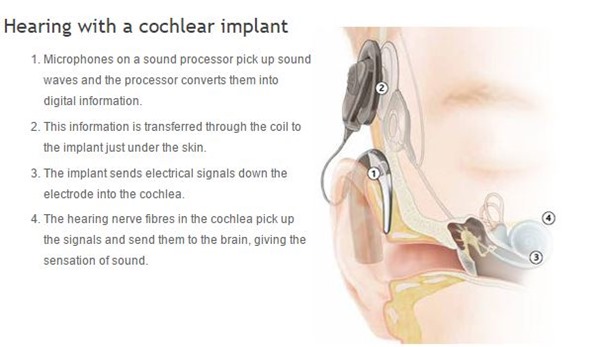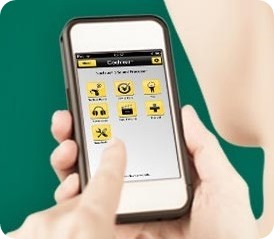Hearing aids capture sound, make the sound louder and then send the sound down the ear canal, through the middle ear to the inner ear where the hearing nerves are located. They are most beneficial for people with mild to moderate hearing loss that may have been caused by factors like damage to sensory cells due to aging, exposure to loud noise, reactions to medications and genetics.
There’s also a so-called “Hybrid Hearing” solution that combines elements of both a hearing aid and an implant, for people who can still hear some sounds, but find it harder to hear conversations in quiet and noisy situations.
For example, they may still be able to hear low-frequency sounds, like a barking dog or car horn, but can’t follow conversations as speech sounds mumbled because they can’t hear the high-frequency sounds which are important for speech understanding.

How have hearing implants progressed over the last decade?
The biggest – and most exciting – changes have been in the improvement of technology in two areas: hearing outcomes and lifestyle.
In terms of hearing outcomes, Cochlear’s latest Kanso™ Sound Processor combines dual-microphone technologies with a so called “Auditory Scene Classifier” to automatically adjust the sound processing to different listening environments, providing a more effortless experience to the user.
Some patients tell us this benefit acts like noise-cancelling headphones because they’re able to hear only the speaker instead all of the outside noises.
Introducing Kanso™ from Cochlear
Next to this, integrated wireless technology is providing huge benefits in difficult listening situations, like a classroom, auditorium or restaurant setting, where patients can now give a small wireless mini-microphone to the person speaking and the sound then gets transmitted directly to their sound processor.

Patients can also stream phone calls, music, and television programs directly to their sound processor using other new types of digital wireless accessories.
In terms of lifestyle improvements, we’ve heard from patients that in addition to the latest technology, they also want a discreet, easy-to-use design. That’s why our Kanso™ Sound
Processor has all elements integrated in one small package, features seamless automation so users don’t have to adjust to various settings throughout the day and also comes in eight different colors to better blend in with a patients’ hair.
What technologies have made these advances possible?
There are a many, but the underlying technologies enabling these advancements are related to microchip technology – enabling more processing with the same or less amount of power – and wireless technology.
We’ve come a long way and I think what we’re able to achieve now is just the beginning of what cochlear implants will look like five or 10 years down the road.
What impact does hearing loss have on peoples’ lives and what level of hearing can be restored by a hearing implant?
The impact of hearing loss cannot be underestimated. It can be felt on a personal level, affecting development, education, self-esteem and socialization, as well as on an economic level which can lead to unemployment, underemployment and lower incomes.
Research has also shown that hearing loss can negatively affect physical, cognitive, behavioural and social functions, and has been linked to increased risks for depression and dementia.
The benefits people can receive from cochlear implants depends on a range of factors at play, but one of the largest indicators is the duration of the severe to profound hearing loss. Early detection and intervention – both in children and adults – are crucial to minimizing the impact of hearing loss.
Children born deaf but implanted before the age of two, for example, have a 90 percent chance to follow main-stream education by the time they get to the age of 6 and have normal or near-normal development pathways.
What factors should people take into consideration when deciding on whether to receive a hearing implant?
If individuals are not able to fully live their life due to disabling hearing loss, which includes holding conversations in-person or on the telephone, they should speak to a health professional about their options.
And they shouldn’t be afraid to get second or even third opinions, because in our experience, many hearing professionals are still not familiar with cochlear implants, their indication criteria and the benefits they bring. When considering what to do, the most important thing is to have all the information.
What technological advancements are in the pipeline for hearing implants?
 We are continuing to conduct research to improve device outcomes, but we also have significant R&D activity underway regarding ways we can better benefit from internet technology to simplify the clinical follow-up process after implantation.
We are continuing to conduct research to improve device outcomes, but we also have significant R&D activity underway regarding ways we can better benefit from internet technology to simplify the clinical follow-up process after implantation.
Already cloud technology, like our Cochlear Link™ solution, is helping to connect healthcare professionals with Cochlear, which can assist with things like speeding up replacement devices, in case a patient loses their sound processor.
Continuing to build upon and enhance applications like this will open so many new opportunities especially as it relates to after-care. This can mean enhanced hearing performance monitoring, less travel to the clinic for device mapping, new rehabilitation processes and more.
We’re also keenly focused on solutions to even better target our patients’ needs. We’ve already begun this journey, as evidenced by some of the personalized features available with Kanso™, but there is ample opportunity to further enhance devices specifically for different segments like pediatrics, elderly patients and so forth.
How many people currently have access to hearing implants and what needs to be done to improve access?
According to the World Health Organization, there are currently 360 million people living with disabling hearing loss worldwide. One in three people over the age of 65 has a form of hearing loss and approximately 37 million people would benefit from the use of an implantable hearing device such as a cochlear implant or bone conduction implant. This highlights a huge unmet need. We need to spread awareness of hearing devices and help people gain access to them.
We’ve been focused on making it easy for people to learn about cochlear implants, in particular using the internet and social media. We’ve placed information in publications like AARP to reach the 50+ audience. We’ve also been working with educational institutions and professional organizations to help carry our messages to hearing health professionals, as well as consumers.
Next to building awareness with candidates and professionals we are also working hard to improve access to make sure that patients afford these solutions. In most developed countries cochlear implants are fully reimbursed through public and private insurers and we recently made great progress in the U.S. for insurance for the new “Hybrid Hearing” category mentioned earlier.
With that said, we realize meeting the needs of the hearing loss community, including awareness and access, now and in the future, requires a coordinated approach. This notion was the impetus for holding The Cochlear Global Research Symposium, October 31 to November 3, where we were able to bring multidisciplinary stakeholders along the entire spectrum of care to problem solve, share ideas and research, and collaborate.
What are Cochlear’s plans for the future?
As a market leader, we feel a great deal of responsibility to help make hearing implants the standard of care. And to do so, we will continue to focus on enhancing technology, increasing awareness and improving access for the millions of people around the globe who could benefit from our solutions.
Where can readers find more information?
Readers can visit Cochlear.com
About Jan Janssen

Senior Vice President, Design & Development and Clinical & Regulatory
Jan Janssen is the Senior Vice President Design & Development at Cochlear and has been active in the area of cochlear implants for more than 19 years.
Jan Janssen holds a Masters degree in Electrical Engineering from the University of Leuven, Belgium and started his career in 1990 with Philips Electronics working on Digital Signal Processing and IC development.
In 1997 Jan became the R&D manager at Philips Hearing Implants (the former Antwerp Bionic Systems), a small Philips division working on a next generation cochlear implants.
When Cochlear acquired Philips Hearing Implants in 2000 and formed the Cochlear Technology Centre Europe, Jan was appointed the General Manager for this operation in Mechelen near Brussels, Belgium.
In 2003 Jan moved to Cochlear’s headquarters in Australia where he set up the Technology Development Program. In 2005 he was appointed to his present role of Senior Vice President, Design and Development.
In this role Jan is responsible for Cochlear's global Technology and Product Development and leads a global team of over 300 highly specialised engineers and researchers.